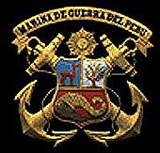

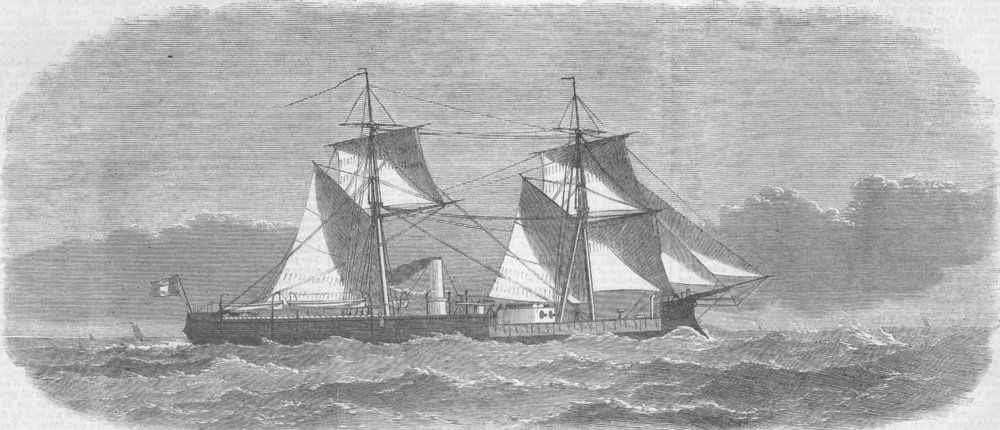 Art print of the Peruvian iron-clad turret ship Huascar, built in the Mersey (Source: The Illustrated London News. February 17, 1866, page 169) |
Built in 1864-66 at Laird Brothers in Birkenhead, England, and launched on October 7, 1865, the Hu�scar was an advanced turret ship custom made for export to Per�. She was one of the few ironclads of her generation to actually engage in naval warfare. Time and again, she proved herself in combat as a rugged, formidable, and well-protected warship.
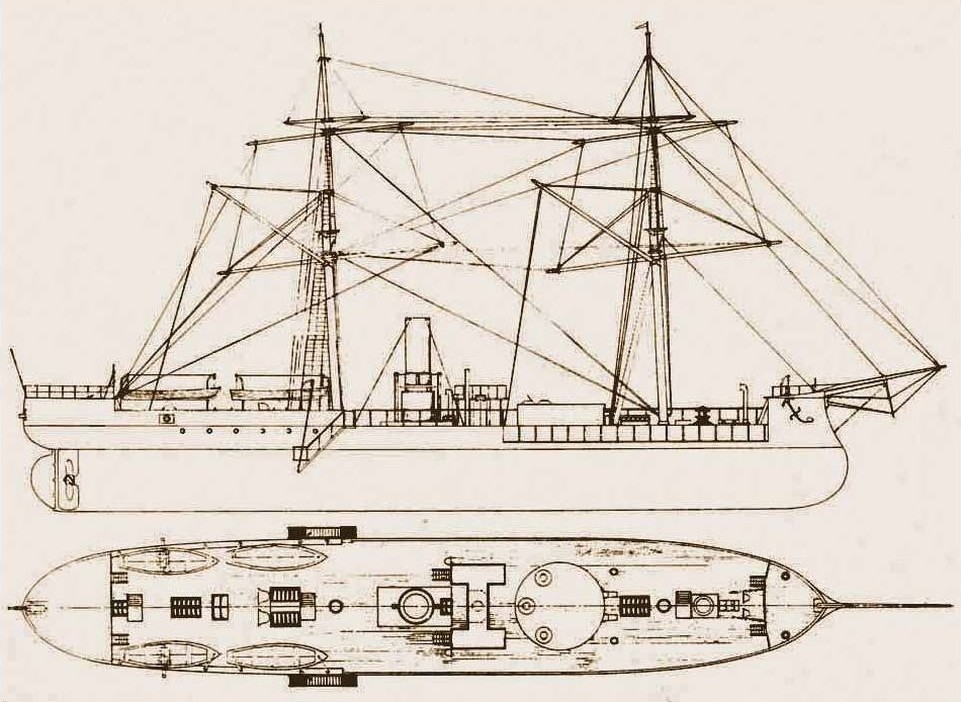 Plans of the Peruvian Ironclad Turret warship "Huascar" in 1865. |
Technical details:
Hu�scar�s armament was disposed in one twin turret and two single mounts, the turret in the waist abaft the foremast and the single 4.5s in armored positions under an enclosed quarterdeck that stretched from the mainmast to the stern. The heavily armored turret was a Coles model as used in contemporary British ships, mounting two powerful Armstrong 10″ 300-pdr rifled naval cannon. This was entirely appropriate, since her designer was Captain Cowper Coles, Royal Navy. As originally built, she had hinged bulwarks that folded down to fire the main guns, the standard arrangement in the 1860s. But the guns� arc was still partially masked by the foremast shrouds. A later refit remedied this defect by removing the foremast, together with all its lines and cables to deck. The ship also had a formidable ram which proved itself in battle. Just aft of the turret, the ship had an armored hexagonal conning station to be used as command center in battle. This tiny battle bridge was an ancestor to the elaborate conning towers on later battleships. Below decks, the ship had four coal-fired boilers powering a Penn Trunk engine, driving a single screw. At her top speed of 12 knots, she was world class � competitive with the best ironclads of her day.
 Original design drawing of the �Huascar� by Cowper Coles. |
Nitrate War:
Bolivian and Chile engaged in a military conflict in 1879 over the confiscation of a mining company and and subsequent Chilean army landing on Bolivian soil. This also forced Peru in the war virtue a secret 1873 defense treaty with Bolivia. Although Peru tried to negotiate and to stop the imminent conflict, Chile, knowing of this defense pact, declared war on both Peru and Bolivia on April 5. The Chile�s aim was to seize the nitrate beds of Peru and Bolivia.
From the beginning of the conflict, both sides clearly knew that control of the sea was the key to obtaining victory. Whichever country controlled the sea could freely transport troops and land them at any strategic point. So, during the first year of the war, Chilean strategy focused on destroying the Peruvian Navy.
The Peruvian ironclad Hu�scar made several incursions challenging the Chilean naval dominion, attacking ports along its entire coast and capturing transports. This sole ship was preventing Chile from invading Bolivian and Peruvian territory, and did so successfully for nearly five months. No attempt to disembark troops could be made, because the Hu�scar was preventing the entire Chilean Navy from taking control of the sea. Several efforts were made in order to capture or sink Hu�scar, but none succeeded.
On 21 May 1879, Hu�scar led the lifting of the Chilean blockade of Iquique. During the battle, Chilean Captain Arturo Prat, Skipper of the corvette Esmeralda, was killed on Hu�scar�s deck. After sinking the corvette by repeated ramming, Hu�scar then rescued the survivors before continuing pursuit of the fleeing enemy ship �Covadonga�.
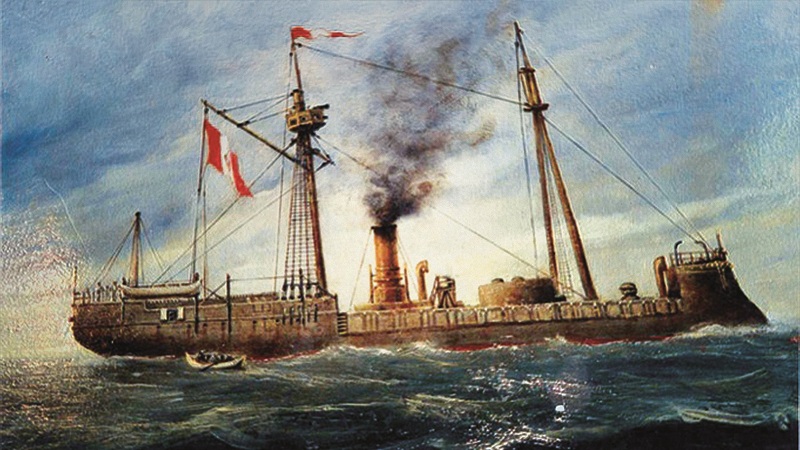 The Peruvian Ironclad �Huascar�, somewhere off the coast of Chile in the late 1870�s (painting by Peruvian artist Fernando Sald�as). |
During the next 137 days Hu�scar under the command of Admiral Miguel Grau Seminario, not only evaded the confrontation with the much more mighty enemy fleet (following orders from the Peruvian Government) but made the coast unsecure for Chilean transport ships. Her biggest prize was Rimac with 260 men of the line cavalry regiment �Carabineers of Yungay�.
Huascar was the flying wall of Peru.
Determined to secure the logistic lines needed for the invasion of Per�, the Chileans committed every possible unit to hunt down Hu�scar. Nearly six months after the naval combat of Iquique, the trap set by the Chilean Navy would be made.
Six Chilean ships � the Blanco Encalada and Cochrane casemate battleships among them � were directed with the sole purpose of sinking or capturing the Peruvian vessel. An ambush had been set up, carefully planned by dividing the Fleet in two: one near the Bolivian coast and the other part waiting for instructions.
On October 8, 1879, near Punta Angamos (Bolivia's coasts), the first part of the fleet, led by the Cochrane spotted the Hu�scar and the corvette Uni�n. After ordering the Uni�n to look for a safe port, Admiral Grau prepared his ship for battle.
The Huascar opened fire on the Cochrane. The latter did not return fire but continued to close. She reached her effective cannon range of 2,200 meters 15 minutes later. The Cochrane began to shell the Peruvian ironclad. One of the Chilean shots pierced the Huascar�s turret, wounding the twelve crew members manning the 300-pound cannons. Another shot perforated the armour just above the Huascar�s waterline, cutting her left rudder chain and leaving her temporarily adrift. The Huascar now was listing hard to starboard and was hampered also by a deformation in the hull acquired when she rammed the Esmeralda during their engagement at Iquique five months earlier. Barely ten minutes later an emergency rudder had been set by the Huascar�s crew.
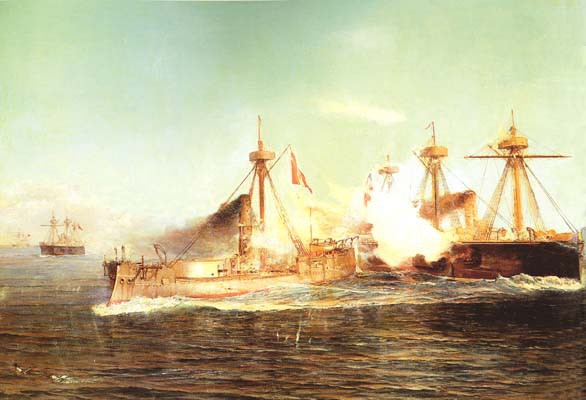 Naval Battle of Angamos (Painting by Thomas Somerscales, an English artist in Chile�s service). |
With the Blanco Encalada and the Covadonga at close range, a shot from Blanco Encalada perforated the Huascar�s artillery tower, killing almost all of the sailors within and damaging the rightmost cannon. Another shot, from the Cochrane, passed through the officers� quarters and wrecked the emergency rudder station, which had been disabled already twice before. The Huascar now could sail only in a wide semicircle to starboard. Once rudder control was regained, Captain Aguirre of the Huascar tried to ram the Cochrane. According to Chileans �Cochrane was manoeuvring to ram the Huascar�, but the Peruvian ironclad, whose steering was again enabled, veered to port in order to ram the Cochrane, Cochrane evaded the Huascar�s ram because of her twin screw and both ships passed by each other. Another shell pierced the Huascar�s artillery tower 12 minutes later, killing all within, including Captain Aguirre. Command of the ship went to Lt. Pedro G�rezon, who in conference with the remaining officers decided to scuttle the ship rather than allow it to be captured. The order was given to evacuate the wounded from the engine room and open the main condensator to scuttle the ship and hence prevent its capture.
The Chilean warships, noticing that the Huascar was decreasing speed, mustered their boarding parties. Nearly two hours after the battle began, 14 to 20 Chileans sailors boarded the Huascar, without encountering any resistance because one of the Huascar�s turret cannons has been dismounted and the Huascar�s weapons room has been destroyed by Chilean shells. Peruvian crew didn�t have any elements of power in order to repulse the Chileans. They closed the main condensator water leaks (with 1.2 meters of water in the engine room) and extinguished several fires while the now captured Peruvian crew was being transported to the Chilean vessels as prisoners of war.
The Hu�scar after Angamos:
The capture of the Hu�scar brought an end to the sea campaign of the Nitrate War. Hu�scar then entered the service of the Chilean Navy. At Arica she fought an duel with the Peruvian monitor Manco C�pac (formerly USS Oneota) while participating in the bombardment of the city � where her new commander Manuel Thomson was killed � and she also aided, without shame and without glory, in the blockade of Callao.
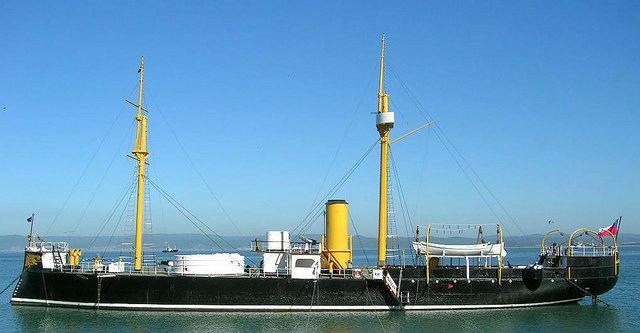 |
The ironclad �Huascar� at present day and painted in colors dating from the times of Queen Victoria of England. She shows her former appearance when she finished her service in the Chilean navy in 1897. Her existing appearance is very different to the warship built in the England shipyards in 1865 and the warship that fought at the Naval Battle of Angamos. In addition this Chilean �Huascar� is not the authentic �Huascar�. |
| More information about Ironclad "Hu�scar": | ||
More about Ironclad "Hu�scar" |
 | |
Hu�scar's guns | ||
The "Hu�scar" designs | ||